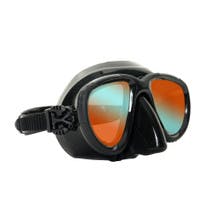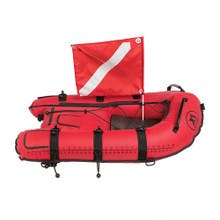How to Manage your Fears in Freediving

You may be interested in freediving, but the potentially terrifying thought of diving down on a single breath could be stopping you. Freediving is a rewarding, yet extreme sport. As with any extreme sports, there are certain risks and fears around those risks that may come up. Learning to manage these fears and trust your abilities is essential. Let’s talk about how to do just that.
Get to Know Your Freediving Fears
Knowing how to manage your fears means anticipating the fears that may arise. There may already be fears you feel about freediving or the ocean in general. There may be fears that you find along the way throughout your training and diving. Getting to know your fears (and being unashamed about having them and having the courage to name them in the first place) is where you want to get started.
Blacking Out
Let’s discuss some common fears associated with freediving. You may have seen videos of freedivers coming to the surface with blue lips and blank stares and found a new fear unlocked—blacking out. The blue lips and discoloration of the skin is caused by hypoxia, meaning your oxygen levels got far too low. The blackout, on the other hand, was caused by your body’s decompression on your ascent. Most blackouts happen while ascending in less than 30 feet of water, called a shallow water blackout. While the lungs and other organs are expanding back to their original size on ascent, they’re pulling what little oxygen we have left from the blood, meaning less oxygen can get to the brain, causing the brain to turn itself off to conserve oxygen and energy. That self-shutdown is a survival technique for the brain so that oxygen can be distributed where it is most needed. There are, of course, other potential reasons for blacking out such as hypothermia, stress, and dehydration, and blackouts can happen even during your static apnea (STA) practices if you push yourself too far. Most people who have experienced blackouts report feeling euphoric or in a dreamlike state just beforehand. Unfortunately, sometimes, there can be some long term brain or lung damage depending on how long the diver was unconscious, not breathing, or if there was water inhaled into the lungs.
Loss of Motor Control (LMC)
Another fear that’s common with people who know the risks of freediving is Loss of Motor Control, or LMC. This is essentially the precursor to blacking out, having reached a level of hypoxia that causes the body (mostly the upper body) to jerk in involuntary movements while the diver is still conscious or semiconscious. Sometimes LMC can be remedied quickly and sometimes it turns into an all out blackout. It looks scary when you see it, but as long as a diver recovers in a timely manner and doesn’t inhale water, there shouldn’t be any long term effects.
If you’re unfamiliar with some of the risks of freediving and I’ve just scared the bejeezus out of you talking about LMC and blackouts, don’t fret. They are just another fear to be prepared for and take precautions against.
Marine Animals
There are, of course, other things that you could be worried about that are more common fears regarding the ocean. Animals, for instance. You may be terrified of sharks or even whales (I mean, dang, they are huge!). Maybe jellyfish stings scare you or even seaweed freaks you out. These things make sense. You’re in an unfamiliar environment, less in control of the swiftness of your movements and you’re in their environment. Understanding the power and abilities that wild animals have when you’re in their world is good to know. You should respect their wildness and unpredictability, but perhaps that shouldn’t inhibit our visits to go and coexist with them. It seems obvious to say to respect their space, don’t stalk, chase, or try to touch them. Most incidents involving a wild animal are due to human carelessness. With that knowledge, we can develop appropriate actions to take while in the water with these fascinating creatures.
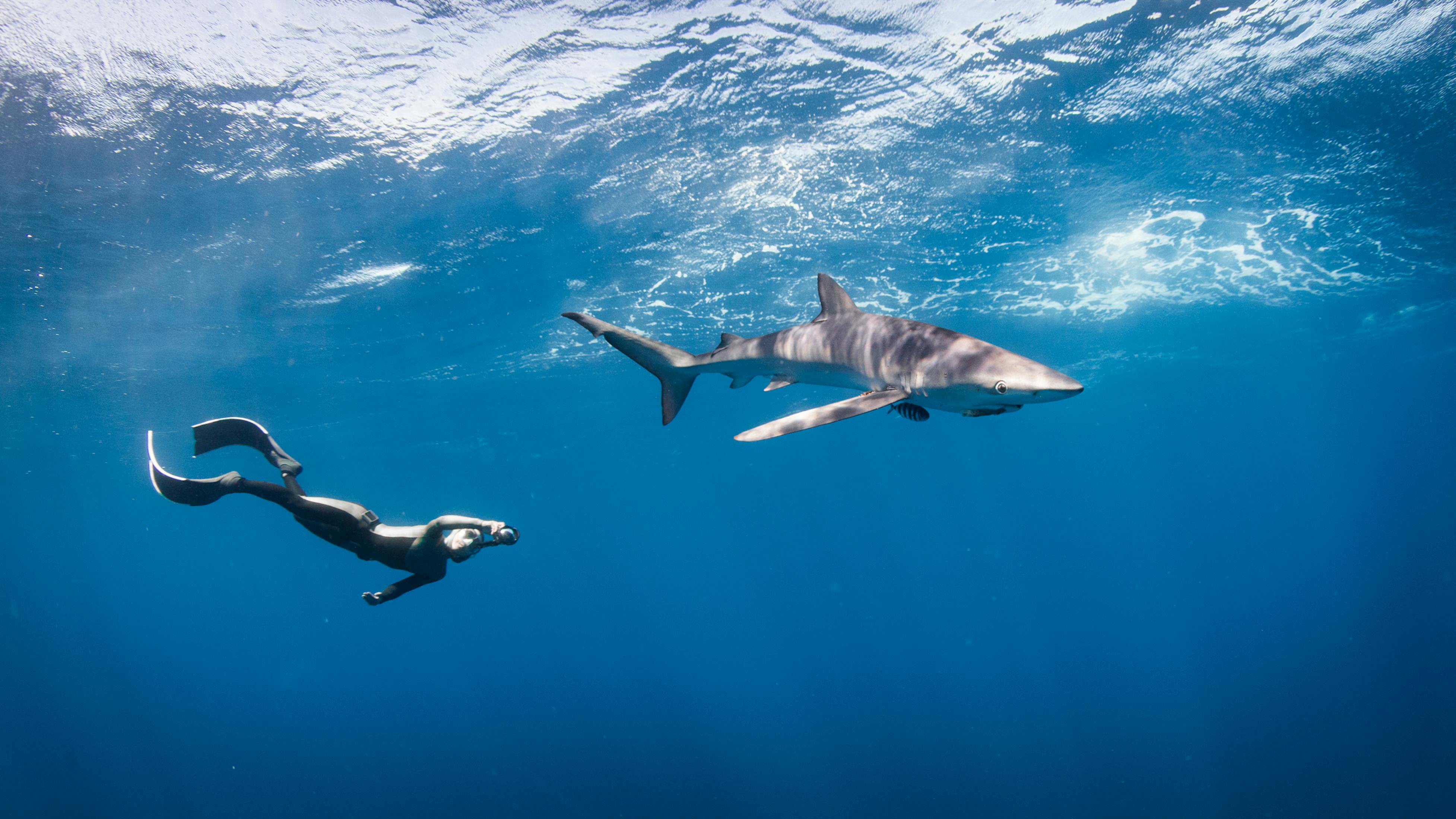
Depth and Darkness
There may also be a fear of diving deep into the water and the darkness there. Again, we’re facing more of the unknown here. You always have the option to simply, not dive that deep down. In fact, as you’re starting out, you won’t be diving very deep at all. As you start to improve your skills, you’ll only gradually extend your greatest depth a little at a time. So simply, dive down to your comfort zone, see what it’s like down there, and on your next dive, see what it’s like to dive a little deeper. Make the unknown known every little bit at a time.
How do we face these fears?
There are a few tried and true techniques that have been developed over the years to manage our fears. Let’s go over a few here to get you past your anxious mind and into your “Let’s Do This” mind.
In James Nestor’s book Deep, he writes about his first freediving training. He was surprised about how well he did with the static apnea, holding his breath for an impressive four minutes. When it came time to dive down into the sea, this is what he said:
“At around two o’clock, it’s time for our last dive attempt. The plate is now sixty-six feet down — the lowest depth allowed for beginners. It’s invisible from the surface. All we can see going down is a yellow rope disappearing into dark green water.
It’s a frightening prospect to dive down into water not knowing where you’ll be when the rope ends or when you’ll take your next breath. Everything I know about surviving in the ocean tells me this is a bad idea. But I start breathing up anyway and prepare to dive.
…By the time it’s my turn, the pressure is on. I try not to look down at the disappearing rope as I inhale my last breaths. Big breath in, bigger breath out. Repeat.
Pinon pulls himself around the float so that he’s right beside me. ‘You need to make this dive. Say, “James is going to make this dive,”’ he tells me. I nod, inhale, duck my head under the water, and climb down the rope.”
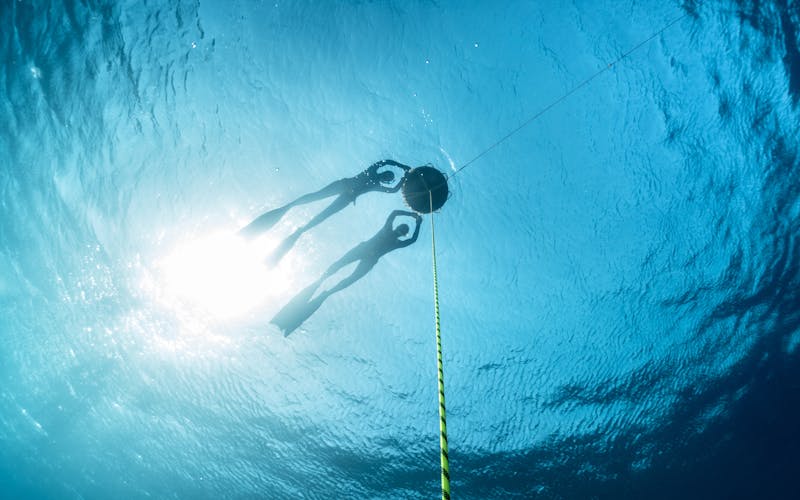
James didn’t make the dive. He made it about 30 feet down and in the midst of confusion about which way was up and what all these sensations were that he was feeling, he turned back to the surface. He later said, “For better or for worse, the residual fear of being down there remained with me.”
Some incredible things happened when James attempted that dive. For one, he was aware that what he was feeling beforehand was fear. He recognized the sensation and breathed through his fear and nerves. He got more in touch with how he feels when he reached a state of neutral buoyancy and discovered more about himself and his responses to that depth and his own fear and discomfort. Could he have made it further down the rope? Absolutely. Did he listen to his body and now know he can at least make it to around 30 feet? He sure did. Also, you’ll notice how Pinon, his instructor, guided him through positive self talk—James is going to make this dive. While we know James didn’t, in fact, make it all the way, that moment of positive self-talk was instrumental to making it as far as he did. Let’s discuss why.
The Navy SEALs’ “Big Four”
Did you know that the Navy SEALs have a set of techniques they practice for mental toughness and surpassing fears? They’re called the “Big Four” and you can use them for anything you’re feeling uneasy about doing, including freediving. They are:
- Goal setting
- Visualization
- Positive self-talk
- Nervous system regulation
Goal setting is our first step. We know the task at hand and we give ourselves a goal. Practicing STA? Maybe we set a goal of 3 minutes for the day. Diving down? Maybe our goal is 20 meters, like James’s goal was. Next, let’s visualize the task ahead. It’s important to remember that you decide whether the visual is a happy place or a scary place. Try to visualize on the positive end of the spectrum. Can you visualize the best possible outcome? Give it a try. Next we have the positive self-talk—James is going to make this dive. We come out of our visualization and say things along the lines of, “I’ve got this,” or “I have the skills to achieve this.” Whatever phrase works for you and your situation. The next step is possibly the most challenging—nervous system regulation. When we’re distressed on land, we use our breath to soothe our nervous system. Obviously, the whole point of freediving is to hold our breath throughout. But breathing is still what’s going to soothe our nervous system, and we do this in the beginning by breathing our bodies and minds into a state of deep relaxation. By preparing ourselves with what are called “breathe-ups” we bring our nervous system into a tranquil state before the apnea begins, ideally maintaining that tranquility throughout our breath-holds.
Breathe-Ups
How do we use our breath to create a state of relaxation? Let’s try it together now. Find a comfortable position, sitting or lying down wherever you are. Take a moment and just notice your breath now. Notice how it moves, where it moves. Take a slow, controlled inhale deep into your lungs, then exhale even slower all the way to the bottom of the breath. Hold the bottom of the exhale for just a second or two, noticing how that feels. Do that again. Take a slow, deep breath in. Then take a slower, deeper breath out. Notice how you feel in mind and body after about a minute or two of that breathing. That calmness that you might be feeling now? That’s what we’re going to focus on on our dive, not the fear. Just deep inner relaxation.
Know the science of breathing (or, rather, not breathing)

We tend to pinpoint our fears on something specific, but often the real source of our fear is simply fearing the unknown. We fear our expiration because we don’t know what’s beyond it. We fear the dark depths of the sea because we don’t know what’s in it. When apnea triggers that “breathe now” response, we get afraid. If we keep holding our breath, what will happen? The desire to breathe and the inability to immediately do so can be scary. Often we think that we are lacking oxygen when we feel that sudden urge to breathe. The panic sets in, and we think if we don’t take a breath immediately, it’s all over. The brain jumps to the absolute worst conclusion.
When we take an inhale, oxygen enters our lungs. The oxygen is still in our system when we start to feel the need to breathe. What’s happening, rather, is the carbon dioxide that we exhale is starting to build up and is trying to escape. If we keep holding our breath, we will start to feel contractions and the need to exhale will increase. This will last a few seconds that may feel a lot longer. There is still plenty of oxygen in our system. You remind yourself to relax through the process, to keep your muscles passive—you know that tensing up both physically and mentally uses more oxygen which you’ll need to continue on with your breath hold. The contraction stage passes. You feel like the breath hold can last a bit longer. And it does. You rise up from the water, exhale slowly, take a sharp inhale followed by another slow exhale. After a few rounds of that, your dive buddy asks how long you think you held your breath for. “Two minutes?” you guess. Surely it wasn’t that long, but somehow it felt like 20 seconds and 20 minutes all at the same time. Your buddy turns the stopwatch around that shows four minutes, hitting your best time yet.
Was it scary? Hell yes. Was there also a sense of security there that you trusted your dive buddy to help you if needed? Was there a feeling of safety around knowing what the process would be like, and reassuring yourself to relax, that there was plenty of oxygen left? Absolutely. The knowing is the cure to the fear of not knowing. Get as educated as you can about this sport and the science behind what’s happening here. Get a freedive buddy who is just as knowledgeable and who you trust.
ALWAYS dive with a buddy/multiple buddies
That leads us into our next stage of freediving fear management—never ever ever go alone. Not only should you not just dive alone (I mean, technically any Joe Schmoe could go swimming with you or hang out on the boat), but you need actually freediving buddies. You need to be diving with people who know what your body and mind are about to go through and who know what to do should LMC, blackout, or some other incident occur. If you’re a meter down and blackout but your buddy can’t dive down more than a few feet at best, we have problems. Freediving is not what should scare you, freediving irresponsibly is what should scare you, and anytime you freedive with other freedivers and freedive safeties, you’re diving much more responsibly.
Know freediving safety procedures and make sure your buddies know them, too
If you haven’t done freediving training before, you’ll find that when you do, you’ll start learning on the first day how to be a safety for your buddies and how to help prevent blackouts for them and yourself. This, among plenty of other reasons, is exactly why you need a freediving certification. Some people have the privilege of being trained from the time they were babies on how to manage (or not lose touch with, rather) the Mammalian Dive Reflex—a physiological phenomenon that happens when we hold our breath while our faces are submerged in water. Those of us who weren’t so lucky to have half mer-folk for parents or guardians have to reconnect with this phenomenon and get to know it all over again. We’re tasked with developing new guardians who will watch over us while we rediscover this natural mammalian instinct, which can take some adjusting. Our guardians need to be trained to know what to do and say while we make these discoveries. Just like we need to know what to do and say for them when it’s their turn to dive. Our freediving training and certification will teach us just that.
Of course, you have your safety buddies, but you also have your safety gear. You have a stable and sturdy float and line. You have a lanyard to connect to the line when necessary. You have first aid and oxygen nearby and someone on the boat, if you’re using one, who has been properly trained in CPR and first aid.
Know your limits
We’ve already mentioned it but it bears repeating, know yourself and know your limits. If your current max depth is 20 meters, don’t try to dive down to 30 meters on your next dive. If you’ve been practicing apnea (really, a practice in acclimating to carbon dioxide build up), you know when your body has had enough and how you respond to that sense of “enough”. That’s a limit. Learn it. Get to know how you respond to stress and your stress limits (when stress becomes unmanageable and panic sets in). What kind of fear responses do you have? Fight? Flight? Freeze? And of course, know your apnea limits. If your STA is currently a steady 3 minutes, it may take a while before you can hit 3:15 or 3:30. There’s no need to push or rush, that’s when we risk blackout. Let your freediving progress be gradual. Sometimes there’s another kind of fear that sneaks up on us—the fear of being bad at something. This fear can trigger the ego to push well beyond our limits and into the danger zone. The good news: You can’t be bad at freediving. You take a breath, you go down (1 meter or 40 meters, doesn’t matter) and that’s it! You’ve practiced and hopefully done so in a relaxed and fun way. Freediving is a competitive sport, but not for everyone and not always. You don’t even need to compete with yourself or your previous personal best. You just go into the sea and enjoy yourself until it’s time to come up again.
Consistent practice and meditation
This goes with anything you’re practicing: Practicing every single day can cause your progress to decrease. At first, you may find that you’ll progress a bit, until you hit a plateau and suddenly, your practice is hindering your performance rather than helping it. Practicing every other day for apnea can be just enough. That way, you’re keeping your body familiar with that sensation of CO2 buildup and mentally training to move beyond it.
It’s no secret that meditation has a calming effect on the body and mind. Daily meditation can help our calmer, more positive mind shine brighter than our anxious mind. Meditation is both hard and easy. Just sit and focus on your breath. That’s all.
Communication
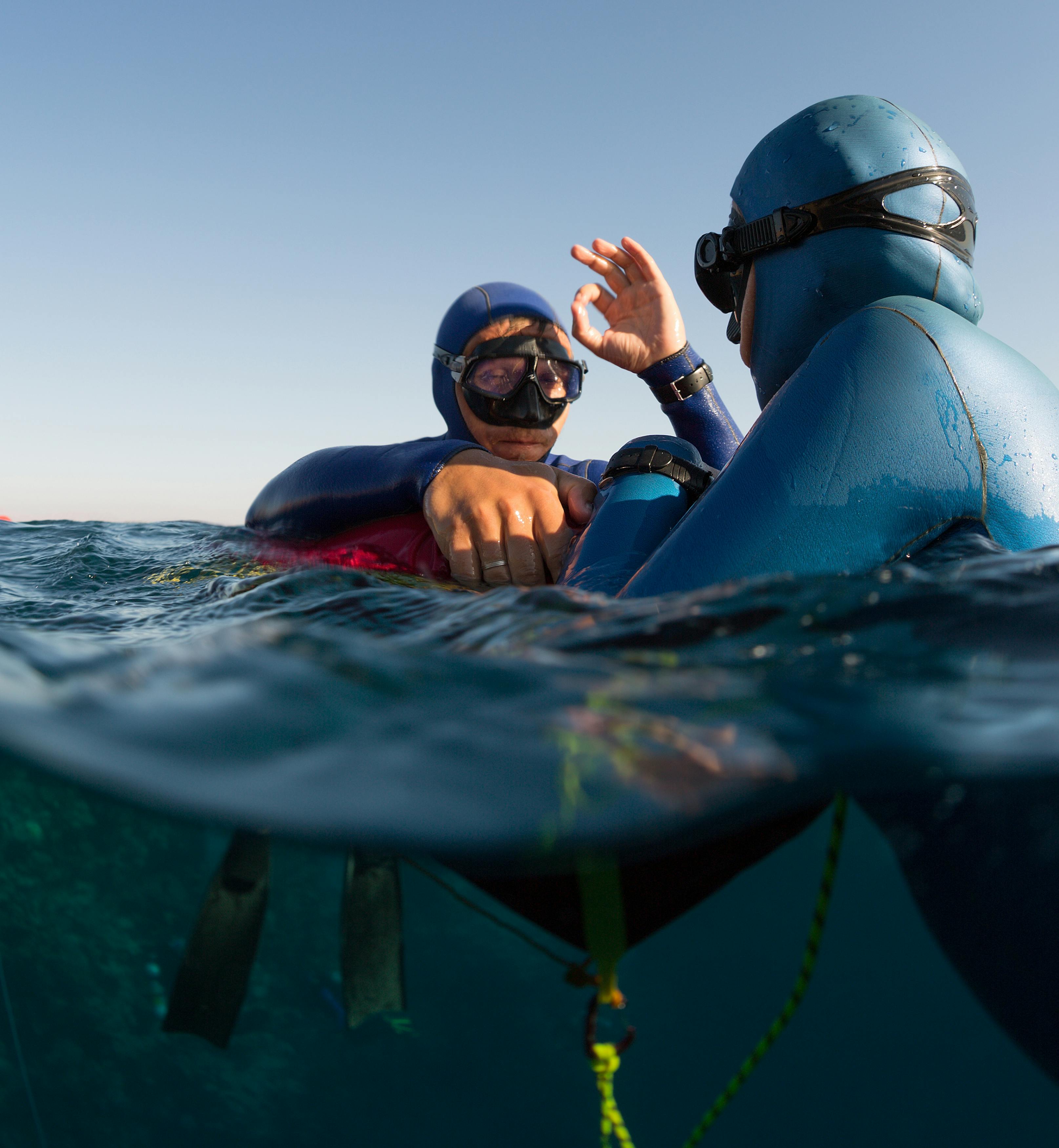
Without the sophisticated language of clicks and whistles that other marine animals have (called codas), we humans simply can’t communicate effectively underwater. That means that you’ll need to be very clear with your dive buddy what your intentions are before you dive down. Are you planning to go down ten meters and swim horizontally a few meters, then come back up? Great! Let your buddy know. Are you going to try to break your own record to dive down to 20 meters today instead of 19? Let your dive buddy know. As you start to develop your practice or any time you dive down, really, your buddy needs to time their descent to meet you as a safety on your ascent. So be super clear about what you intend to do before you dive down. That way, if you start to deviate, your buddy has a faster indication that something might be wrong. They won’t need to spend extra energy (thus oxygen) looking for you or chasing you around unaware of what you’re up to. Everything is clear and planned out. This is an essential element to your apnea practice. This goes for when you’re practicing your static apnea as well. Whether you’re in the water or sitting in your living room, have a buddy there to time you and check on you. Your buddy should tap you on the shoulder every so often and you’ll respond in whatever way is efficient for you (often simply lifting a finger for a moment will do). This silent communication between you two will reassure your buddy that you’re still alert and doing well.
“I’d Like to Speak to the Manager”
When it comes to fear, be a Karen. Ask to speak to your own inner management system to handle the situation appropriately. We’ve assessed the potential fears associated with freediving, and now it’s up to you to decide if freediving is worth the risks. If you love it or love the idea of it, but your anxieties are the only thing stopping you from jumping in, try a few of these fear management techniques to jump in more confidently and safely. Know your stuff to the point that it feels like second nature to you. After that, it’s all in keeping yourself relaxed and calm and surrounding yourself with knowledgeable and able freediving buddies.
FAQs
Are freediving courses worth it?
Absolutely! It is never a waste of time or energy to learn from a professional how to do extreme sports, like freediving, safely.
Why is freediving so dangerous?
Freediving involves holding your breath, something the body tends to avoid naturally. But people have been freediving for millennia. The more in touch we are with our bodies and minds, the more we can feel the signals telling us when it’s time to surface. Ignoring those signals or pushing far past our limits can cause hypoxia, resulting in LMC, blackouts, and other issues.
What is the safest way to freedive?
With other trained freedivers and well within your limits! Easy. Don’t push too fast to get to whatever you think is the next level for you and always have dive buddies around who know what your plan of action is.
Are there any benefits to freediving?
Yes! Freediving can actually help to relieve stress and anxiety, it strengthens your respiratory muscles (ideal for better breathing), and can help improve your fitness and flexibility.


